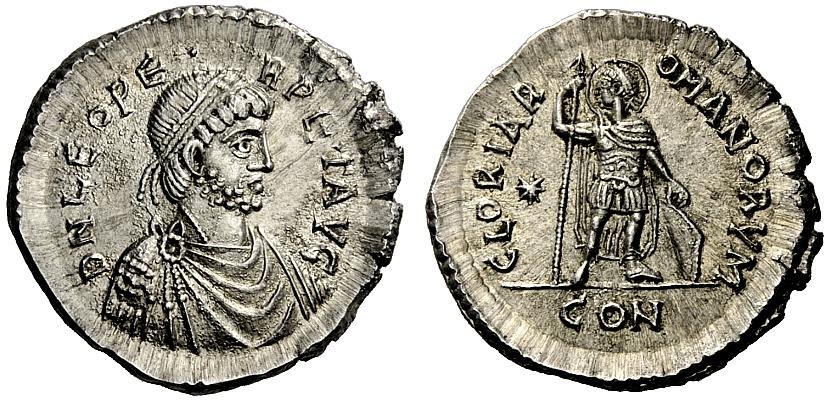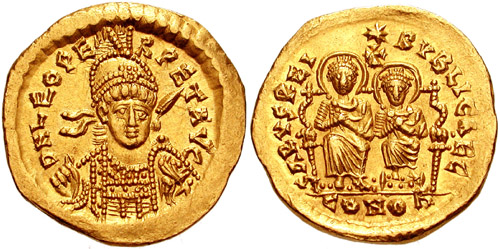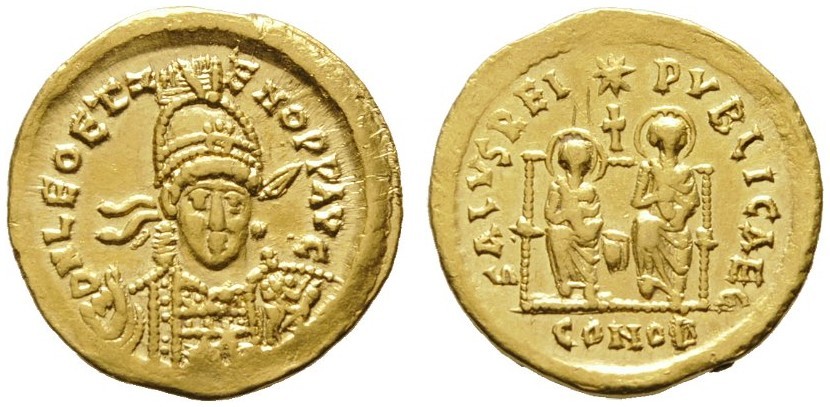
Proposition of datation of a Leo II's Solidus
Leo I, known as the Thracian, was raised emperor by Patrice Aspar in 457. Leo not being able to have a male descendant, he turned to Aspar's son, Patrice, who married his daughter Leontia before 470. We have no information on the age of Patrice but we do know that in 459 he was already consul and that he was named Caesar in 470 – therefore heir presumptive to Leon – before dying in 471 Leontia, widow, will then be remarried by her father to Marcian, the son of the Western emperor Anthemius (497-472).
For his part, Leo II was born in 467 and lived until 474. It was therefore at the age of only seven that he died and the circumstances of his death remain unknown. He is the son of Zeno and Aelia Ariadne, the eldest daughter of Leo I. This grandson of the sovereign was therefore associated with power. Leo I in October 473 raised his grandson to the rank of Caesar then, in November, to that of Augustus. On the death of Leo I in January 474, his grandson did not resist pressure and named his father Zeno co-emperor in February. Leo II is Augustus alone for less than three weeks: from January 18 to February 9.
The solidus we are analyzing shows on the reverse a small nimbate and diademed character wearing the imperial mantle and holding a cruciger globe. The question therefore arises: who is represented on this monetary series?
.jpg?1642775757617)
Fig 1
Photo of a coin sold the 11/05/2005 by Numismatica Ars Classica, Auction 29, lot 670, link to the sale: https://www.acsearch.info/search.html?id=222443, link to their website: https://www.arsclassicacoins.com/.
A/ D N LEO PE – RPET AVG.
R/ SALVS REI – RVBLICAE C _ CONOB.
Two variants exist, they show a reverse where the letter P of REIPVBLICAE is normal and another variant where it is replaced by the letter R as for our coin above. Error or other intention? It is not important for what we seek to understand here. On this subject Grierson and Mays (1) do not agree with Kent (2). Two names and four dates are possible. First, the terminal letter C on the reverse is analyzed by Grierson and Mays to be Caesar's initial, while Kent believes it is the immobilization of the letter C as the G of the usual inscription AVGGG. Grierson and Mays see no problem with the small figure on the reverse wearing a tiara while being Caesar. I agree with their opinion by adding that the engravers could not always think of every detail of their engraving and that, moreover, an emperor is always represented wearing the diadem in this Vth century. To finish on this point, I also think that the portrait on the obverse, resolutely adult, may have prompted the engraver on the reverse to image a character with all the usual attributes of an emperor.
Grierson and Mays estimate that this strike was made between 470 and 471 when Patrice, son of Aspar, was named Caesar. I confess to having great difficulty agreeing with this theory. It seems to me, as a preliminary to my demonstration, that this period of one year may have sufficed to produce a much larger number of coins. But this is not certain. On the other hand, what is problematic is Patrice's age on this date. If we do not know when he was born, on the other hand he is already married in 470 and above all he was consul eleven years before in 459... So we would have at least one big teenager who would be represented. Let us remember Gordian III and his representations on the reverse. However, it seems all the same that our solidus shows a child. If Patrice was represented then why would he be alone? At no time was he alone in power. This other point still leaves us perplexed as to a representation of Patrice. There are no cases where a young co-emperor is depicted alone on the reverse. If this were the case and we cannot totally exclude it, we would be in front of a real innovation. The question that then comes to mind is the choice of legend. Why let SALVS REIPVBLICAE and not use a legend commensurate with the representation. Imagine for example LEO ET PATRICIVS... We could also, if this character were actually represented, think that the coins showing the two seated emperors could show us this same Patrice. Wouldn't it be more logical to imagine it is Leo II on all these coins?
Even if we cannot prove that Patrice was never represented, we must take a big step back by counting the too large number of elements suddenly becoming very strange and almost illogical if we admit the presence of Patrice on the reverse of the coin. We also have the example of the heavy miliarenses on the reverse GLORIA ROMANORVM. As this one (Fig 2) :

Fig 2.
Photo of a coin sold the 17/05/2012 by Numismatica Ars Classica, Auction 64, lot 1364, link to the sale: https://www.acsearch.info/search.html?id=1275962, link to their website: https://www.arsclassicacoins.com/.
These silver coins show us how the emperor is depicted with an adult appearance. And so there is almost no doubt that the solidus we are looking at shows someone other than Leo I and above all a child. We must then definitively start from the principle that it is about Leo II. There are three possibilities :
- October to November 473, when Leo I was Augustus and Leo II Caesar.
- November to January 474, when the two emperors were co-Augusts.
- January 18 to February 9, 474 when, his grandfather having just died, Leo II was Augustus alone.
The type where we see two seated emperors with the tallest figure seated on the left is the one most logically thought to have been created between October and November 473. The place of honor is on the left (i.e. on the right from the point of view of the figures) and it is indeed Leo I who is represented there. These coins also include an element which had not been noted until now: the use of the footboard. Let's look at the coin below (Fig 3) :

Fig 3
Photo of a coin sold the 12/01/2004 by Classical Numismatic Group, Triton VII, lot 1064, link to the sale: https://www.acsearch.info/search.html?id=157741, link to their website: https://www.cngcoins.com/.
Under the character on the right who is the child, we see a footboard. The same object is present on the solidus showing a single emperor (Fig. 1). I think so, it still connotes the young age, perhaps even very young age of the character alone. We also observe that the adult character on the left places his feet on the ground. The footboard is known for adult characters and in a standing position, but here there is no doubt that it is a way for the child to be able to rest his feet because they do not touch the ground. Only a very young child is not able to touch the ground with his feet when sitting in an adult chair. It is therefore logical not only to see Leo II sitting on this solidus with Leo I but also to exclude Patrice who was taller given that he was already married and consul eleven years before being named Caesar. This footboard used for the character standing and alone, on our enigmatic solidus, would therefore illustrate this seven-year-old child, namely Leo II, as he would have been shown to the public. Mounted on a step in order to be made visible by the people because of his very small size. Note, however, that this footbard is not represented on the variant SALVS REIPVBLICAE C, RIC X n° 802.
This footbard is also used under the two feet of Leo II, so it is probably nothing more than a means of being raised. And not a step often used under a single foot of the emperor representing elevation, the means to achieve something or superiority.
Again we don't have indubitable proof but all these points that I raise tell us that the most logical path would be to see Leo II as only Augustus as Kent thinks. Another problem arises: the use of the letter C for CAESAR (if this letter actually indicates this title). And for this I can provide clear answers. This letter C is also present on the coins showing Zeno and Leo II! Here is a copy (Fig 4) :

Fig 4
Photo of a coin sold the 07/11/2016 by AuktionsHaus H.D. Rauch GmbH, Auction 102, lot 613, link to the sale: https://www.acsearch.info/search.html?id=3449144, link to their website: https://www.hdrauch.com/site/de/.
If this copy is quite worn, there are others of better quality which leave no doubt about the presence of the letter C, for example the coin illustrated in the RIC X, plate 27 n° 803. It is therefore a beautiful anachronism that we observe ! Leo II is seated in the place of honour, the footboard has disappeared but one can understand the desire to remove this element in order to enhance the image of the young emperor who is in any case destined to become an adult. We can also see Zeno's right leg which seems abnormally raised as if the engraver had imagined his uncomfortable position on a chair that was too small. But this is not seen on other specimens. It is therefore for informational purposes that I mention this point. Zeno is co-Augustus and not Caesar, this letter C is perfectly illogical and shows that it designates Leo II who, although Augustus, remains a Caesar because of his young age. That is to say an emperor waiting to be able to exercise. At least we can start from this idea. Another theory is however possible about this letter C. This letter clearly designated the word CAESAR on coins of previous centuries, let us quote for example the legends with NOB(ilissimus) C(aesar). But I propose that this letter could mean here : coniunctim, therefore jointly or another word beginning with the letter C and of similar meaning. The anachronism then disappears. But fortunately, if this letter C was used to identify a Caesar and therefore a character, the exclusion of this "proof" is replaced by my demonstration on the footboard and the problem of height and age of Patrice. On the other hand we see the use of the same legend under Leo I and under Leo II with Zeno, which tells us that it is indeed Leo II who is present each time, there is little doubt on this point. Still about this letter C, we can clearly see that if it indicated the title given to Leo II, then the minting of these coins would in any case have continued after his new title of Augustus. We observe the disappearance of the letter C replaced by a officina letter. This does not correspond to the time when Leo II is Augustus, therefore from November because the letter C returns later during his joint reign with Zeno.
The corpus of these coins, with or without a terminal letter C – which is not, I have demonstrated, Caesar's initial – is too large to correspond to a short striking period. This point further emphasizes that the letter C corresponds to a term indicating the sharing of the role of savior of the Republic in a joint manner. And especially that this type is "immobilized" and that it can be estimated that the representation of Leo I may have been used after his death.
What we must finally clarify is the date of striking of this series where the emperor is represented alone. We can propose the period from January 18 to February 9, 474 when Leo II is in fact Augustus alone. The problem of the obverse portrait then arises. There is no doubt that we observe Leo I there. The portrait is adult and it is in the continuity of the coinage of Leo I. This effigy is also similar to those of Basiliscus and Zeno, for his coins before the fourth issue. A child's face could not be depicted on the obverse. And the officials in charge of choosing the monetary effigies certainly thought, given his age, that his actual reign would come much later and that he would again be associated with another sovereign. It took less than three weeks for Zeno to become co-emperor. Possibly therefore, we would have a posthumous striking showing Leo I on the obverse leaving his grandson alone on the reverse. But this letter C indicating a joint reign is then illogical ! I therefore imagine that this strike took place shortly before the death of Leo I. She begins to represent Leo II alone, because those close to Leo I no longer had any doubts about his imminent end: Leo II was going to be sole emperor. January 474? We can assume so.
It is difficult to envisage an earlier date, because these strikes exist only in very small numbers, while the other solidi showing the two sovereigns are much more frequent. Would this brief series then be included in the middle of the other where the two emperors are seated? We can doubt it. I therefore propose, in the light of all that has been exposed, a simple chronology: the reverse with the two seated emperors where Leo II is on the right, followed by the representation of Leo II alone: either. in January 474 period when Leo I is moribund, or between January and February when Leo II is the only sovereign in title (which would explain the few copies struck), but then Leo I is featured on the obverse posthumously and the letter C would therefore constitute a "ghost" , recalling the period of joint reign desired by Leo I and the survival of his political heritage.
(1) Ph. GRIERSON & M. MAYS, Catalogue of Late Roman Coins in the Dumbarton Oaks Collection and in the Whittemore Collection. From Arcadius and Honorius to the Accession of Anastasius, Washington, 1992, p. 162 et cat. N° 532 et 533.
(2) J.P.C. KENT, Roman Imperial Coinage. Volume X. The Divided Empire and the Fall of the Western Parts. AD 395-491, Londres, 1994, p. 103 et 109.